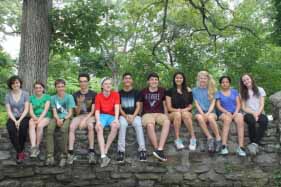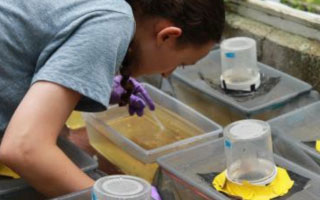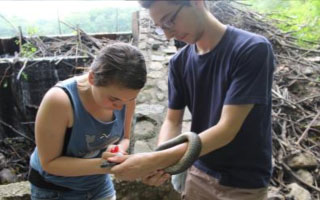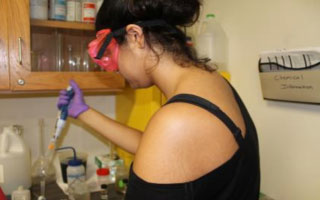 Teatown celebrated another successful year of its Teatown Environmental Science Academy (TESA). This is the third year the program has been offered at Teatown and this year we hosted eleven students from eight Westchester high schools who each chose a research project to undertake on Teatown’s 1,000 acre preserve.
Teatown celebrated another successful year of its Teatown Environmental Science Academy (TESA). This is the third year the program has been offered at Teatown and this year we hosted eleven students from eight Westchester high schools who each chose a research project to undertake on Teatown’s 1,000 acre preserve.
This hands-on, experiential four week program provided the students with an introduction to all the necessary skills to undertake scientific research in the field.
 Each student conducted research, analyzed data and presented their findings at a symposium held atPACE University’s Environmental Science Center. Students this year were from Hong Kong International School as well as Briarcliff, Croton, Horace Greeley, Lakeland, Mamaroneck, Sleepy Hollow, andYorktown high schools.
Each student conducted research, analyzed data and presented their findings at a symposium held atPACE University’s Environmental Science Center. Students this year were from Hong Kong International School as well as Briarcliff, Croton, Horace Greeley, Lakeland, Mamaroneck, Sleepy Hollow, andYorktown high schools.
Dr. Mike Rubbo, Teatown’s Director of Conservation Science and Hillary Seiner, Teatown’s Conservation Scientist, mentored the students as they conducted their independent research. They worked closely with each student, providing guidance on data collection and analysis in the lab.
A wide variety of topics were selected for study by the students which included:
Becca Marcus, sophomore at Mamaroneck High School: The Effects of Triclosan on an Aquatic Food Web
Mariam Nagani, junior at Yorktown High School: A Tale of Two Nutrients: The Effect of Duckweed on Water
Quality
Heidy Arana, junior at Sleepy Hollow High School: The Effect of Filamentous Algae on Water Quality
Christopher Werni, junior at Lakeland High School: Frogs and Fish and Snakes, Oh My… and Water Quality
Emily Olivier, sophomore at Yorktown High School: Lily Pads: Helping Teatown Lake Since the Mid-1900
Amar Bhardwaj, senior at Hong Kong International School: Invasive Plant Leaf-Litter in a Lake Ecosystem
Liam Cushen, junior at Yorktown High School: Algae-whiz! The Effect of Nitrogen and Phosphorous on Algae Growth
Charlotte Brodie, senior at Croton High School: Recreational Trails Invite Humans and Invasive Species
Matthew Mackenzie, junior at Briarcliff High School: A Camera Trap Survey of Wildlife on a Suburban Preserve
Sarah Fant, junior at Croton High School: Could Garlic Mustard (Alliara petiolata) Inhibit Indian Pipe (Monotropa uniflora) Success?
Freddie Mildenhall, junior at Horace Greeley High School: Roads: An Invasive Species’ Favorite Mode of Transportation
 The program culminated in a symposium at which each student presented their research findings. At the symposium, the students answered challenging questions from the audience, honing their presentation skills.
The program culminated in a symposium at which each student presented their research findings. At the symposium, the students answered challenging questions from the audience, honing their presentation skills.
Dr. Rubbo said, “It is a pleasure each year to work with a new group of intelligent and engaged students that have an interest in environmental science. Our goal is to provide the students the tools they will need to continue to conduct research as they move along in their studies.”
 Teatown’s Executive Director Kevin Carter said, “We are so pleased by the success of the students in our TESA program. This program has proven to be a valuable stepping stone for students interested in science research programs offered inmost area high schools and many of Teatown’s former TESA students have gone on to win awards atcounty science fair competitions, including WESEF, as well as at the international science fair competition, ISWEEP.”
Teatown’s Executive Director Kevin Carter said, “We are so pleased by the success of the students in our TESA program. This program has proven to be a valuable stepping stone for students interested in science research programs offered inmost area high schools and many of Teatown’s former TESA students have gone on to win awards atcounty science fair competitions, including WESEF, as well as at the international science fair competition, ISWEEP.”
Teatown Lake Reservation, an environmental education organization with a 1,000-acre private, not-for-profit nature preserve in Westchester County, is one of the largest and most active environmental education and science centers in the region. Teatown impacts more than 20,000 adults and children every year through its full schedule of year-round programs and nature-focused summer camp, as well as through 15 miles of hiking trails. Teatown’s mission is to inspire our community to lifelong environmental stewardship. It has grown continuously since it was established on 194 acres in 1963, 50 years ago.







